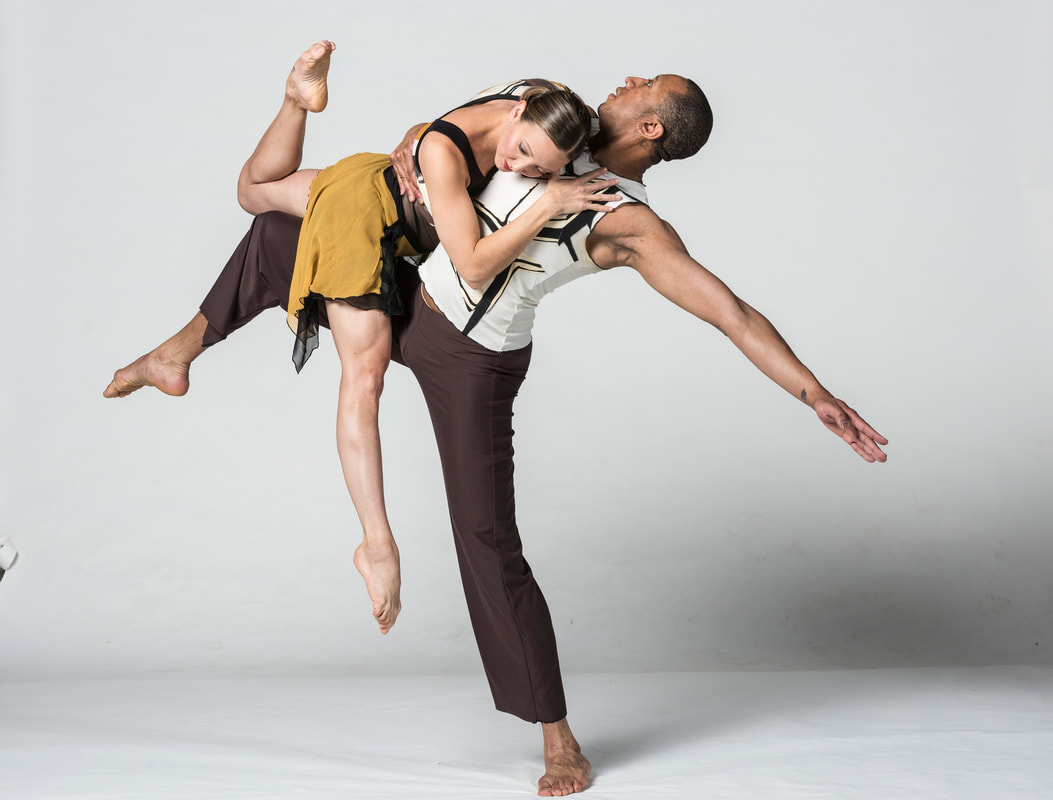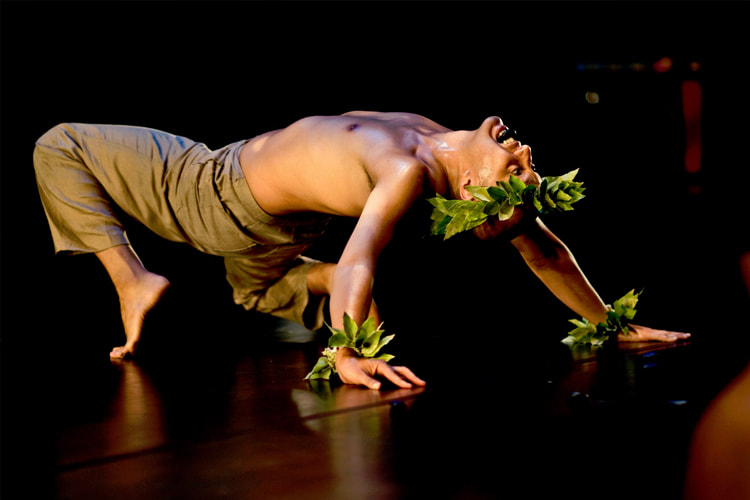|
Photo by Gary Gold The best thing about Ellen Sinopoli Dance Company is its willingness to experiment – not just on the part of its artistic director but its six dancers too.
Part of that eagerness to test its artistic stretch comes in the form of collaboration with all kinds of other artists and art. And one of the more pleasant and enduring experiments is the modern troupe’s annual showing at the Opalka Gallery at Sage College in Albany. On Friday evening, the ensemble was cradled in the realm of a Kathryn Field’s nature paintings and figurative sculptures. There, the company unleashed its whirling sensibilities to reflect on Field’s creations with three works in the company’s repertory and six dancer-made solos that are based on Sinopoli’s “Solo Flights.” Dancers selected certain works that spoke to them – Louisa Barta loved the glowing leaf paintings; Andre Robles, the abstract sculpture of stone and driftwood; and Laura Teeter, everything of color. These little solos, while charming and revealing of each dancers’ personality, were mere interludes for three of Sinopoli’s pieces that she restaged for an audience sitting on all four sides of the room. What makes the Opalka evenings so intriguing is the dancers are close – toe-to-toe with the audience. In this intimate setting, the audience can feel their power, hear their breath and see with searing clarity the shapes that Sinopoli is so well known for creating. But it is the theme of nature and the physical body – like the paintings and the sculpture -- that overrides the evening. Sinopoli wisely selected such works as “Texture of the Whole,” a work she created with physicist and University at Albany professor Keith Earle, as the ensemble opener for the evening. Here the dancers draw out concepts of physics in a series of crashes and constructions in ways that explore the beauty and force of the science. “Clusters,” a collaboration with choreographer Rob Kitsos, was also shown. To music that ebbs and flows, the dancers assemble and disperse in as if a breeze, sometimes stiff and other times gentle, tosses them about. Sara Senegal is a raging storm throughout, plowing through others and hurling dancers about in a way that feels violent. While “Texture of the Whole” and “Clusters” still carry the eye, none of Sinopoli’s works can compare to the mastery of her “Dreams.” The first work she created for her company still holds up and captures the imagination. To the minimalist music by Avro Part, the duet, staged here with Teeter and Robles, is a head first fall into the mystery of sleep. The dancers begin, standing, rocking back and forth like the pendulum of a clock, marking the time before they descend into the abyss. At that moment, the audience is captivated and stay with the dancers throughout their restless slumber. An amazing work, “Dreams” remains one of Sinopoli’s best. And no matter how many times I see it, I am forever beguiled by its exquisite honesty.
0 Comments
Christopher K. Morgan performs his solo "Pohaku" at PS/21. “Pohaku,” a solo by Christopher K. Morgan, begins with the passing of rocks.
Audience members stand in the aisle, transporting stones hand-to-hand in a chain from the back of the theater to the stage. At its edge, Morgan kneels, accepting each piece of earth to build a solid stone shrine. And as his solo unfolds, one realizes what Morgan is really building is his fractured relationship with his Hawaiian culture – one pebble at a time. This deeply personal work, onstage at PS/21 in Chatham, blends stories, hula, modern dance with traditional and classical music to transport its audience to world of wind and water. Once on this a beautiful, isolated Pacific terrain, Morgan alerts us to a culture that has been trampled upon and nearly decimated. But with people like Morgan, whose parents were Hawaiian, but did not live on the islands, the songs, the stories and the dances are alive again. And more importantly, they are relevant. Morgan begins his solo as if a wave. He tumbles and tosses his frame back and forth across the stage. When he finally stands, he sways like a guava tree in the breeze. His nature imagery ripples into traditional hula dances – loose rolling hips topped off by arm and hand gestures that appear inviting to both the audience and unseen spirits. But he can also act aggressively, stomping his feet, moving his bend legs in and out like an accordion and jabbing the air with a stiff arm. And because the weather was cool, a steady stream of steam curled over his head – like a hot cup of tea brewing off of his crown. That alone gave audience a sense they were experiencing something special. Accompanying him are Elise Kaleihulukea Ryder performing traditional chants and percussion and Wytold, an electronic cellist – all sounds that draw the audience further into this exotic, distance landscape. The music quiets when Morgan speaks. He recalls the language of his childhood and the stories of his parents, particularly his mother who joined the military, trained in segregated Mississippi and became an electrical engineer. He also speaks of last island monarch Queen Lili’uokalani who was overthrown by wealthy U.S. landowners for control of the sugar industry. Throughout he sprinkles touches of the language and projections of both women and the Hawaiian scenery on screens of handmade paper. While the “Pohaku,” Hawaiian for stone, is infused with melancholy, a longing for a culture overrun. But at the same time, Morgan gives us hope. As he rebuilds his Hawaiian connection, he is also rebuilding the culture. One leaves “Pohaku” understanding its importance. And even though we only glimpse a sliver of Hawaiian songs, dance, stories and history, we too become carriers of the stones that will rebuild the island’s heritage. Sunday night is the last showing of “Pohaku” at PS/21 and the last showing of any performance under the tent. Next summer, the outdoor venue moves up the hill and inside into a permanent structure – complete with bathrooms, dressing rooms and rehearsal space. That has always been the plan. It took 12 years to get there, but the intrepid founder and President Judy Grunberg got it there. Congratulations PS/21. |
Wendy
|


 RSS Feed
RSS Feed
